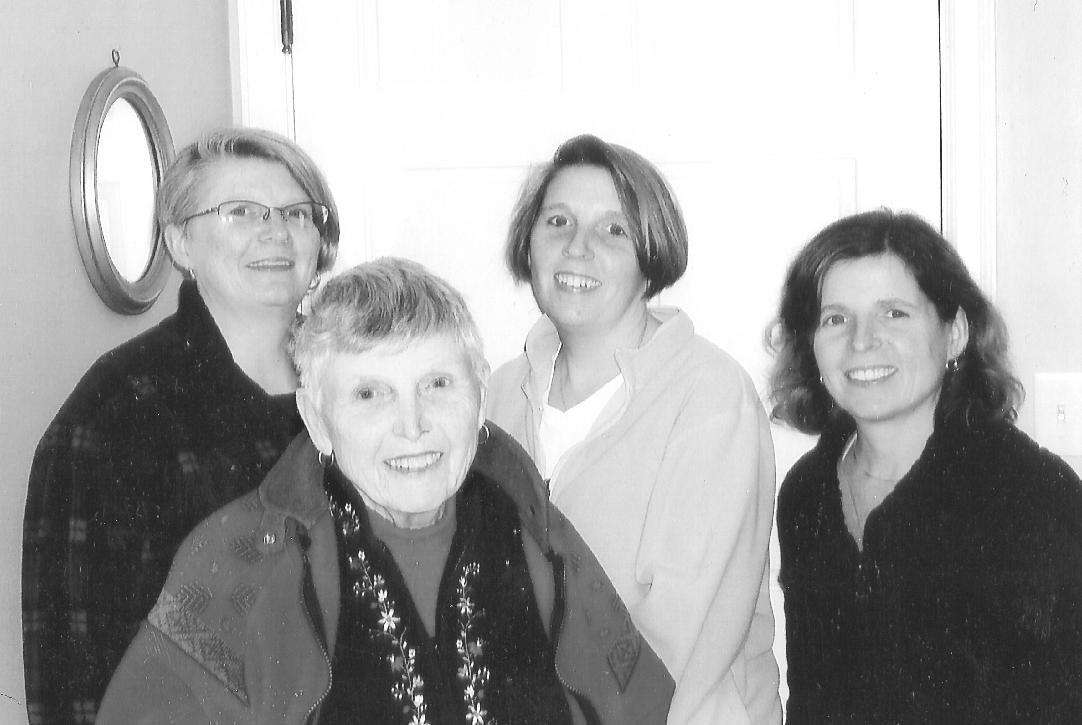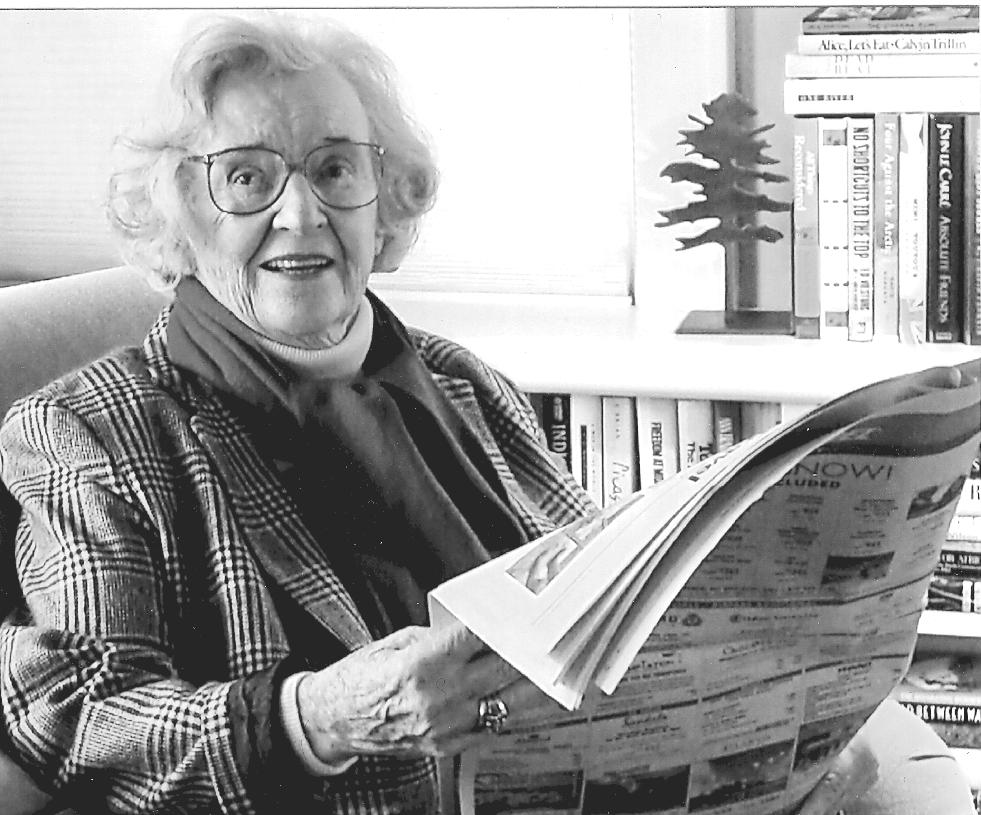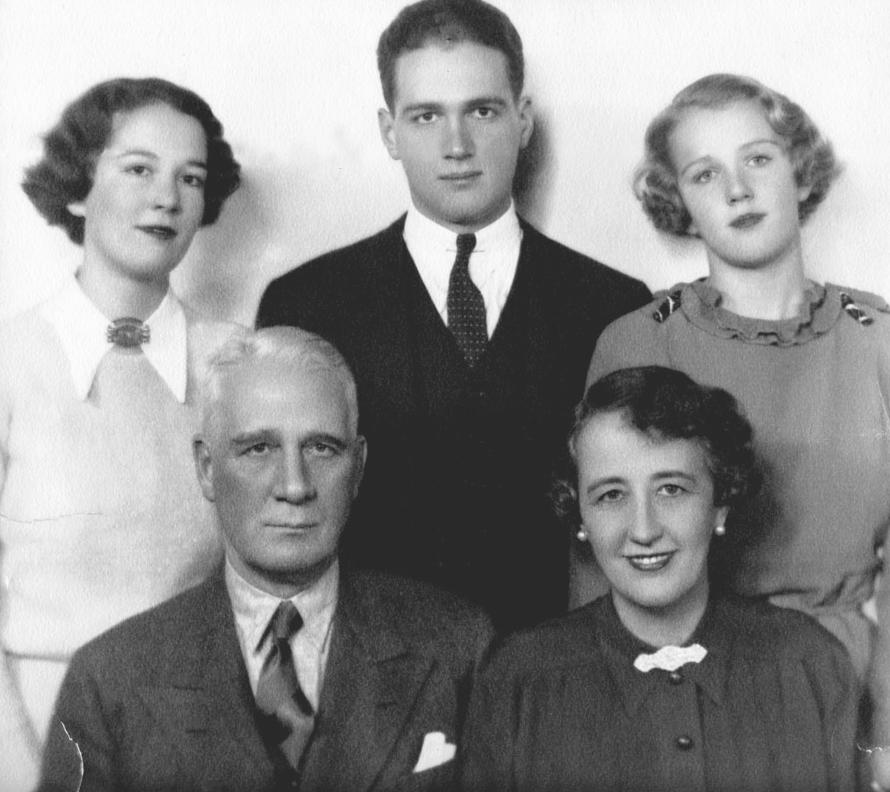
10 minute read
Jane Thomas noland ’49
Jane and family, also known as Noland Four Creative Services, Inc., 2008
from beatles to bearables
Advertisement
Jane Thomas noland ’49
interviewed by Holly duff dowds ’71 on July 26, 2008
Sitting on Jane Thomas Noland’s front porch on Lake Minnetonka, watching the ducklings waddle towards the water, there is a deceptive sense of calm. She grew up on this property and comments, “We’re looking at the same view I’ve looked at off and on for 80 years!” But once she starts talking, you know that hers has been no leisurely life of lawn chairs. She sums up her life as “nonstop work,” mostly writing and editing— combined with parenting, also nonstop. From her beginnings as a newspaper reporter, she now has at least one book with a million, plus or minus, copies in print and four adult gift books translated for more than 10 overseas markets.
Jane’s family first came to Minneapolis from Indiana in the 1920s, when her father used his food chemistry knowledge in ways that affect us all. First at Washburn-Crosby company, which became General Mills, “He kept weevils out of flour” by establishing one of the first corporate quality-control departments in the United States. His department supervised the test kitchens, featuring the mythical Betty Crocker. He also worked to vitamin-enrich white flour as an industry advisor to the FDA during World War II. “Immigrants didn’t want dark flour—it reminded them of poverty,” Jane remembers him saying.
Both mother and father set expectations for Jane, their only child, incredibly high. “Mother, in particular, was obsessed with education. I had to be a fantastic student. I had to be a good athlete because my father (a four-sport undergraduate letterman, an Indiana state tennis champion, and former athletic director of Butler University) never had a son. The expectations caused me plenty of anxiety.”
In the ’30s, frugality was a strong family value—even a necessity. “We lived in Kenwood, and trucked out to Lake Minnetonka in the summers. I remember ‘hoboes’ coming to our back steps in Kenwood from the railroad yards to get food handouts. We had household help, because everybody needed a place to live in those Depression years.”
On the day Jane was born, her father’s sister died, and the four orphaned nieces moved in with Jane’s family. Overnight, the number of children in the house went from zero to five. (One of the nieces, Natalie Osterhout, was a member of the Smith class of ’35.) And Jane’s mother’s sister lived nearby. “So I grew up in a family of women—Dad’s ‘harem.’ It was the era of the Lindbergh kidnapping, so my mother protected me like no other child before or since. I couldn’t sit on the front steps alone. She was that way until I got married, and afterward too.”
Jane’s mother stressed healthy living before it was in vogue. Both parents were teetotalers, to the point of bribing Jane with a diamond to not drink (the same diamond her mother’s father had given her for the same reason).

One of Jane and daughter Mimi’s “bear books,” based on Lake Superior bears and now reprinted in seven foreign countries
Jane’s mother knew how vulnerable families could be—seven of her nine Irish uncles were alcoholics. At parties where drinking was the post flapper-age norm, she would quietly pour her drinks into plants. “I’ve killed more potted palms than you can imagine!” Jane remembers her mother saying. Lesson learned. Jane doesn’t drink and never has.
Jane, who says, “I always knew I’d go to Smith,” cites her youthful visits to the annual Smith Day in the Country as a reason. Another was the Smith College English Award given at Northrop Collegiate School, where she attended (“I think I won that, but I’m not sure”). She made a tour of colleges and thought “Northampton was the most beautiful place in the world. So it was understood that I would get in and I would go—that was that.” Besides, three other classmates from the Northrop class of ’45 went to Smith: Jean Guthrie (Bodine), Jane’s friend since birth; Mary Wurtele (Vaughan); and Jean Dunn (Robb), who lived in Capen House for four years with Jane. All four stayed to graduate in 1949. (Mary Vaughan’s interview is on page 70.)
Jane’s years at Smith were filled with exciting teachers, especially in the English department. “R.G. Davis was a writing teacher at the time. Bob Bailey, who taught a course in novel writing, had us over to his house. We were a small, cozy class, and he’d invite people like Bernard De Voto [a Pulitzer Prize–winning, controversial author] to come and talk to us.” And there was Mary Ellen Chase. “She was a joy, you know. She was like an old-fashioned minister—she’d wave her hands around and get red in the face and spout Bible verses as literature, and you’d never forget them.” Next to her English literature major, Jane’s interest was music, which was her minor. Writing Rally Day songs started her on a lifetime of compulsive songwriting, shared by her musical family.
At Smith, Jane formed several lasting friendships, including with her roommate, Bea Weeks Bast of Philadelphia. Jane, Bea, and a nest of ’49ers have reconnected in Delray Beach the past few years. Like many, Jane credits Smith’s house system. “We had the whole second-floor front wing of Capen House our senior year.” There was individual house dining at that time, and few transferred out. It made for a cohesive group. “We were the first class back in Capen after the war—the WAVES moved out, and we came in.”
A “guilt moment” came after graduation. “I was hired to be an English teacher at Dobbs Ferry, and, on seeing their catalog photos of yet more girls in gym clothes with their hockey sticks, I decided that 11 years in girls’ schools was enough.” She moved back to Minneapolis, and, after reviewing books for the Minneapolis Tribune, was hired as a city-side reporter, working nights. Jane was transferred to the Women’s Pages (no longer called the “Society” section), where, she said, “We put the whole section together in those days. We’d write the articles, compose and fit the headlines, supervise the typesetters who set the lead type in forms, and finally proof the pages. A total operation. We worked like dogs for $35 a week, but it was fun.” Longtime columnist Barbara Flanagan and Susan Kuehn were reporting colleagues, and the three traveled to Europe together on the Queen Elizabeth.
“I was married late—to Richard F. Noland. I was almost 30, Dick 34. In those days of ‘graduate one day, get married the next,’ we like to say we were the only ones left!” He was a writer too, in advertising, first as an agency copywriter and copy chief and then in his own business in the Ivy Tower.”
With parenthood came the challenge of her life. While there is no alcohol in the Noland house except on a few special occasions, both of Jane’s children, Rick and Mimi, became chemically dependent. (They have now been sober for 22 years and 33 years, respectively.) With her typical soft humor, Jane murmurs appreciation for the fact that the children at least “took turns.” “It was a very hard time to bring up children, the late ’60s and early ’70s.” Working with Irene Hixon Whitney ’48, another Minnesota Smith alum who was an early proponent of alcoholism treatment, Jane helped start youth halfway houses—Shanti House and Way 12 Halfway House.
At age 15, Mimi wrote a book, I Never Saw the Sun Rise, about recovering from chemical dependency. That’s when Jane went into the book business. A new self-help publisher in Minneapolis, CompCare Publications, was printing Mimi’s book and “they needed someone to write the bottom half of A Day at a Time, a Twelve Step daily reader for people in recovery.” The book is now published by Hazelden, which took over many of CompCare’s books when the latter’s parent company in California folded the Minnesota

With lifelong friend Jean Guthrie (Bodine), c. 1930—Jane (right) and Jean were born two days apart and went to nursery school, Kenwood, Northrop, and Smith together

In front of Capen House at Smith, 1949
operation in the mid-1990s. “I was at CompCare for nearly 20 years as their senior editor. I could write a book like Laugh It Off (about losing weight) and carry the whole project through—edit it, choose an illustrator and cover designer, proof it, take it through the production process. What a luxury for a control-freak author!”
Along the way, Jane tried traditional volunteer service—as Art Institute docent, airplane spotter (a wartime leftover), Children’s Hospital poison-proof promoter, and a founding board member of Highcroft School, Shanti House, and the Wayzata Chemical Health Commission. But she concluded that you contribute more if you do what you do best— in her case, writing. Looking at the global distribution of her books, no one could argue. Jane’s “Bearables” books (Bearables: Parables of Bear Wisdom for Everyday Living, Bear Up, Bear Ways to Cope with Life’s Bumps and Surprises, and Bear With It), are all based on real behaviors of Lake Superior bears. Illustrated by Mimi’s Thurber-like bear drawings, the Bearables books are still coming out overseas. Counting the Rings, Jane’s comprehensive history of Encampment Forest Association for that lakeside community near Two Harbors, was published in 2001. And her What’s So Funny about Getting Old? with Ed Fischer keeps selling for Meadowbrook Press.
“I’m still editing memoirs for people and still writing poetry. I just won $20 for a children’s poem and got this nice note saying: ‘Good luck with your future writing career.’ That was kind of a kick. I’m not going to tell them I’m 80!” Reflecting on high points of her life, she lists marriage (“a really good one”), the birth of her children, achievements like Phi Beta Kappa and seeing her work in print, and giving help to those recovering from chemical dependency.
As she reviews her career of nonstop work, she wonders if the Puritan work ethic is as necessary to civilization’s progress as it seemed to her earlier, or as proclaimed by her parents and teachers. “People can contribute in so many different ways. High expectations can be either life-enhancing or destructive. In my case, I think they were enhancing. I did what was expected, rose to the challenges. In the case of my children, the only grandchildren of four hovering grandparents, I think expectations were destructive, or at least discouraging.”
Even with those endless expectations in her childhood and her nagging work ethic, Jane’s friends can attest to the fact that she’s a barrel of fun, basically a humorist. The main turning point in her life? “The Beatles—no question! We took the children, aged 5 and 7, to the Beatles’ concert at the Chicago Stockyards.

In front of Capen House, 1999, wearing her 50th reunion shirt with the motto “XLIX est L … A CLASSIC IS BORN”
We drove there with a sign in the back window that said ‘Beatles or Bust.’ Dick and I were the original grown-up groupies. We went to every rock concert, heard them all—Cream, the Grateful Dead, Jefferson Airplane, Joe Cocker, the Who, everybody! Of course, both kids wanted to be rock stars—still do!” The Nolands are a musical family, and they have their own recording label, Blue Zoo Music, a division of Noland Four Creative Services (advertising, writing-editing, illustration, music). Their house is “maxed out” says Jane, with the clutter of cottage industries, including Rick’s antique business.
As a Smith alum, “I’ve been a house rep for reunions, written reunion songs, been to all my reunions but the 5th and 55th. For years, I frustrated the Minnesota Smith Club with wicked Smith Day quizzes. Now I try to keep track of classmates—I’ve been class co-secretary for the past five years and have co-written the class column for the Smith Alumnae Quarterly.”
What advice does Jane have for all of us? “Of course, there is the ever-increasing importance of education and an informed electorate,” she says. “And kindness and honesty, as I’ve told the kids, are the two most important things we can learn to make the world a little better.” t










